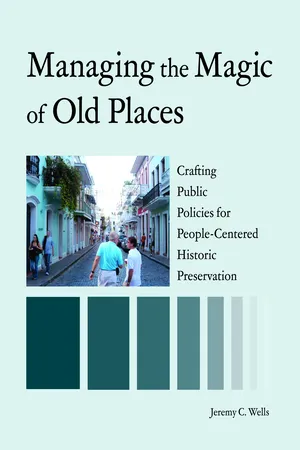
Managing the Magic of Old Places
Crafting Public Policies for People-Centered Historic Preservation
- 287 pages
- English
- PDF
- Available on iOS & Android
Managing the Magic of Old Places
Crafting Public Policies for People-Centered Historic Preservation
About this book
From 1849 to the early 1980s, the development of US historic preservation policy was shaped by fewer than one hundred elite White men from Europe and America. This orthodox preservation doctrine has too long silenced the vibrant, experiential relationships between everyday people and their heritage. Managing the Magic of Old Places: Crafting Public Policies for People-Centered Historic Preservation offers a radical rethinking of how historic preservation is approached in the United States.
Author Jeremy C. Wells argues for a revolutionary shift in federal preservation policy—one that embraces community-based participatory practice and draws from environmental psychology to tap into the intangible, emotional connections people have with old places. Wells highlights the experiential values that laypeople often ascribe to historic environments, which are frequently dismissed by expert-driven policies. He contends that if historic preservation policy continues to ignore these aspects, the field will lose relevance as the gap between professionals and the public widens. Drawing from interdisciplinary research in the social sciences, particularly phenomenology and environmental psychology, Wells's vision of public preservation policy centers the lived experiences of communities, reinvigorating the field and ensuring that the preservation of historic places resonates with a wider, more inclusive audience.
Wells positions his work within the growing field of critical heritage studies, yet his focus on the psychological and emotional aspects of preservation distinguishes it as a unique contribution. By placing the needs and experiences of the public at the heart of preservation efforts, Wells critiques the historical foundations of US preservation policy while offering a bold agenda for reform.
Frequently asked questions
- Essential is ideal for learners and professionals who enjoy exploring a wide range of subjects. Access the Essential Library with 800,000+ trusted titles and best-sellers across business, personal growth, and the humanities. Includes unlimited reading time and Standard Read Aloud voice.
- Complete: Perfect for advanced learners and researchers needing full, unrestricted access. Unlock 1.4M+ books across hundreds of subjects, including academic and specialized titles. The Complete Plan also includes advanced features like Premium Read Aloud and Research Assistant.
Please note we cannot support devices running on iOS 13 and Android 7 or earlier. Learn more about using the app.
Information
Table of contents
- Contents
- Preface
- Acknowledgements
- Introduction
- Chapter One Challenging the Authorized Discourse on Built Heritage Conservation: Why Doctrine and Policy Are Not People- or Human-Centered
- Chapter Two Being Affected by Old Places and the Person-Patina Relationship
- Chapter Three Pure and Naked Heritage: Revealing the Vulnerability of Orthodoxy
- Chapter Four Transforming Historic Preservation Policy to Manage Charm
- Chapter Five Overcoming Historic Preservation's "Resistance to Research": Creating an Informed Policy
- Chapter Six Time for Change
- Appendix A. Authors of Built Heritage Conservation Doctrine
- Appendix B. Conducting a Guided First-Person Existential Phenomenology
- Index